Mechanical Vapor Recompression
Home / Mechanical Vapor Recompression
Mechanical Vapor Recompression (MVR) is a process used for evaporating liquids, and it typically involves the use of a mechanical compressor to recycle and reheat vapor generated during the evaporation process. The specifications of an MVR system can vary depending on the application and specific requirements, but here are some typical specifications and parameters to consider:
Capacity: The capacity of an MVR system is usually specified in terms of the rate at which it can evaporate liquid. This can be measured in liters per hour (L/h), gallons per hour (GPH), kilograms per hour (kg/h), or other relevant units. The capacity depends on factors like the type of liquid being processed and the desired concentration level.
Heat Source: MVR systems require a heat source to provide the energy needed for vapor compression and evaporation. Common heat sources include steam, hot water, or electrical heaters. The specifications should detail the heat source requirements and capacity.
Vapor Compressor: The heart of an MVR system is the vapor compressor, which is responsible for compressing the vapor to increase its temperature and energy content. The specifications should include information about the type, capacity, and efficiency of the compressor.
Condenser Type: MVR systems typically have a condenser to convert the compressed vapor back into a liquid. The type of condenser (e.g., surface condenser, shell-and-tube condenser) and its specifications should be included.
Vacuum System: Some MVR systems operate under vacuum conditions to reduce the boiling point of the liquid. The specifications should detail the vacuum system’s capacity and requirements.
Control System: Modern MVR systems often come with sophisticated control systems for temperature, pressure, and flow rate regulation. The specifications should describe the control system’s features and capabilities.
Energy Efficiency: The energy efficiency of the MVR system, often expressed as the compression ratio or specific energy consumption, is an essential specification for assessing operating costs and environmental impact.
Dimensions and Footprint: The physical dimensions and required installation space of the MVR system should be provided in the specifications.
Materials of Construction: The materials used in the construction of the MVR system are important, especially when dealing with corrosive or abrasive liquids. Common materials include stainless steel, carbon steel, and various corrosion-resistant alloys.
Safety Features: Specifications should include information about safety features, such as pressure relief valves, alarms, and emergency shutdown mechanisms.






